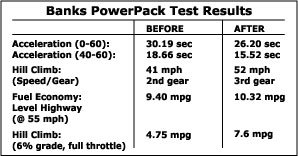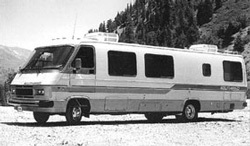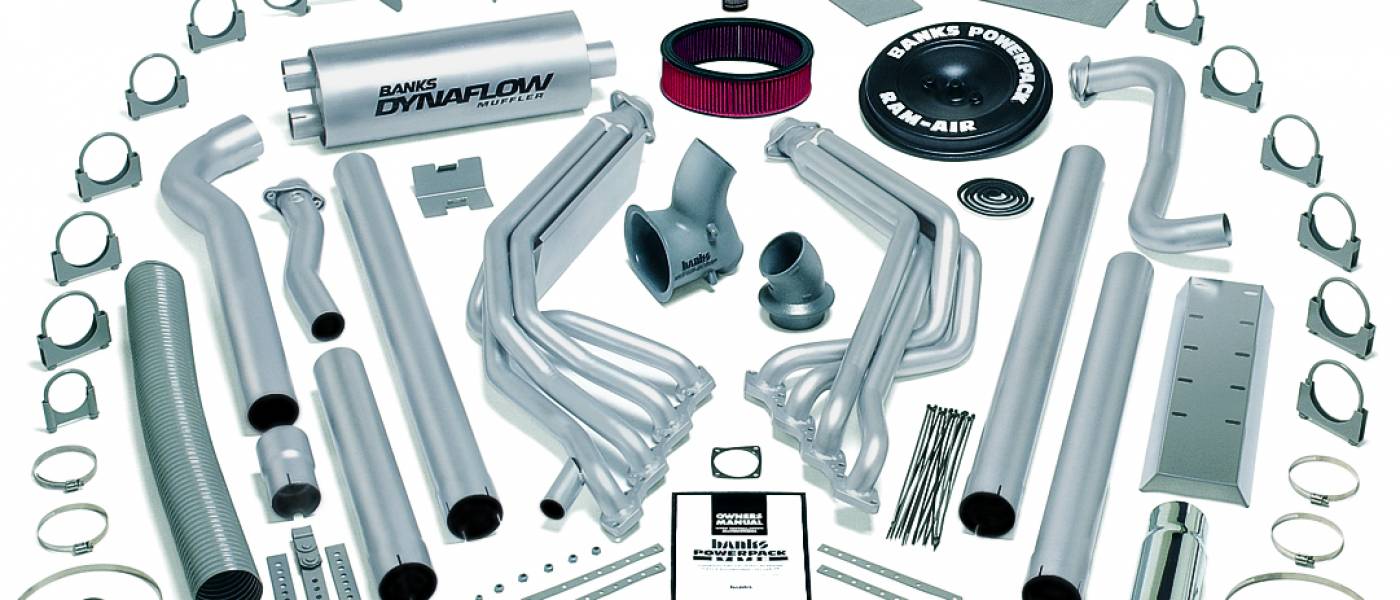Rx for Power
MotorHome May 1998
For as long as there have been internal combustion engines, efforts have been made to improve their efficiency. This type of engine has long been compared to an air pump. Air comes in, air goes out, and a combustion cycle takes place in between to keep things running. It seems only logical that one way to increase efficiency would be to improve the ease with which air can flow through the engine. Without this free flow of air through the intake and exhaust systems, the engine is actually struggling against its own inability to breathe.The Banks PowerPack® intake and exhaust systems improve engine breathing, resulting in better performance and fuel economy for the GM 454
Gale Banks Engineering has developed the Banks PowerPack for the GM 454-cid engine, a kit that completely reworks the intake and exhaust systems from one end to the other, to make air flow through an engine more efficiently. In addition, part of the kit consists of a new set of governor springs to alter the transmission shift points under full throttle.
The marriage of all these components is designed to make the engine breathe easier, run stronger and improve both performance and fuel economy. According to Banks, a modification such as installing a set of headers won’t result in significant performance gains because the engine’s ability to breathe depends upon making major changes in the way air is delivered to the carburetor, as well as how it is channeled away in the exhaust system. Headers, he says, are in the middle of the system and can’t contribute much improvement to an otherwise strangled system.

During research and development of the PowerPack, the Banks people left no stone unturned in their quest for the optimum intake and exhaust systems. Over a period of several months, they tested numerous theories and designs, some of which are even used on Formula 1 race cars. But they discovered what is best for a race car is not necessarily best for a motorhome. By utilizing some of the highly sophisticated instrumentation developed for their twin-turbo Pontiac Trans Am, which was built to set new land-speed records at the Bonneville Salt Flats, the engineers were able to accurately monitor engine response to intake and exhaust system modifications that couldn’t be monitored on a dynamometer. Some of the things they learned through research took them by surprise, appearing illogical at first glance but rendering significant performance improvements. Every aspect of the final design was carefully engineered for optimum improvement of the engine’s ability to breathe.

On the intake side of the engine, everything from the fresh air back to the carburetor is new. Just behind the grille is a specially designed cold-air inlet chamber called a ram-air Super-Scoop. The Super-Scoop opening faces directly into the wind, creating a ram-air effect. The term “ram-air” refers to the fact that the air is being forced into the intake system, creating a positive air-intake pressure. The amount of force is directly proportional to the velocity of the vehicle, so the faster you go the greater the ram-air effect. At cruising speed, the effect of the ram-air is similar to that created by a supercharger, but in a minor way. Because of this positive pressure, the combustion chambers are more thoroughly cleared of residual exhaust gases by scavenging action during the brief period of time in which both the intake and exhaust valve are open (known as valve overlap). This allows the next air/fuel charge coming into the combustion chamber to be fresh, rather than being diluted by residual exhaust gases. This scavenging action also reduces combustion chamber temperature because the hot exhaust gases are more thoroughly cleared away.
Normally, intake air must be sucked into the combustion chamber by the vacuum created as the piston descends in its cylinder. Cylinder vacuum is developed at a cost, however, relying on neighboring pistons that are being driven downward by the combustion process to turn the crankshaft, creating the energy to pull a piston down in the cylinder against the resistance of vacuum. But with a Banks Ram-AirTM System, the intake air is already being forced into the combustion chamber under pressure, in essence reducing the amount of vacuum necessary to complete the intake cycle. This reduces the amount of horsepower that is lost to the simple expedient of creating vacuum in cylinders to draw in the fuel/air mixture. The result is additional horsepower that can be used to propel the vehicle down the highway.
The other positive aspect to ram-air scoop is that it is positioned far enough ahead of the engine compartment that the incoming air is cold and dense, which is exactly what engines like best. Tests done by Banks indicate that the temperature of intake air reaching the carburetor can be more than 100 degrees F cooler when drawn from a good cold-air position, rather than being drawn from within the engine compartment.
The Banks Super-Scoop is designed in such a way that it automatically separates out of the incoming air any moisture, low-flying birds, slow-moving pedestrians and heavy particles of dirt. These contaminants are expelled through an outlet and drop harmlessly to the ground. Fresh air flows from the chamber, through a length of 4-inch-diameter flex-hose, to the inlet nozzle of the air filter housing.
The cast-aluminum air filter housing features an inlet snorkel that flares wider toward the main housing body, permitting the incoming air to flow swiftly and smoothly around the filter. The housing is larger than stock, providing plenty of room for air to move around the filter.
Inside the housing is a Banks Ram-Air Filter, renowned for its superb airflow and contaminant filtration characteristics. This filter employs a gauze curtain that is saturated with oil, forming a viscous barrier that is very effective at trapping dirt. This filter is meant to last the lifetime of the vehicle because it is washable. Banks includes a container of filter cleaning solution and another of filter oil to renew the element when it gets dirty.
Everything to this point is for maximum airflow to the carburetor. According to Banks, the stock intake system is very restrictive to airflow, choking the engine and preventing optimum performance. The PowerPack removes the choke points and allows the engine to inhale easier.
On the exhaust side of the engine, every part of the system is discarded and replaced with stainless steel PowerPack components. With exhaust temperatures on carbureted 454s as high as 1400 degrees F, high-grade stainless steel is the only material that promises a long life. According to Banks, the PowerPack essentially becomes a lifetime exhaust system because stainless steel resists corrosion and deterioration due to high temperatures, unlike the stock system that rusts out and needs replacement every few years. Banks says his system should outlive the coach.

Building a tuned exhaust system is a project of complexity, but the potential rewards of a proper system are tremendous. By customizing the diameter and the length of the pipes, removing kinks or bends that are too tight, and developing a muffler that is quiet without unnecessarily restricting the exhaust escape route, exhaust gases can be evacuated without creating unwanted backpressure. Excessive backpressure in the exhaust system is an enemy of performance and fuel economy, causing the engine to struggle against itself.

The Banks TorqueTubeTM exhaust manifolds feature individual mandrel-bent pipes to channel exhaust gases away from each exhaust port. A heavy machined steel flange plate was developed to offer a gasket-free fit. This is important because when an exhaust manifold gasket fails, exceedingly hot gases escape and can cause damage or even a fire in the engine compartment. The Banks engineers designed and machined the new manifolds with the precision fit necessary to preclude the use of a gasket.
The individual pipes come together at a collector that is designed with a venturi effect, which takes advantage of each exhaust pulse to help scavenge the gases from adjoining pipes. The length and shape of this collector were the subjects of much experimentation during the development of the PowerPack system. The intent was to come up with a chamber that enhanced the exit speed of the exhaust gases, rather than slowing them down. The final design offered the best results, but looked to Banks like it would restrict the exhaust. He still chuckles over how he was completely surprised by what turned out to be the best collector design.
Beyond the collector, the exhaust enters pipes leading to the muffler. The Banks-designed special low-backpressure Dynaflow® muffler is 304 stainless steel material. As the exhaust gases enter the muffler, they pass through a chamber, which utilizes the exhaust pulses from one pipe to help scavenge the gases from the other. This is called cross-scavenging. From there, the exhaust travels through a 3-inch-diameter pipe until it reaches the tailpipe, which is graced with a 3 1/2-inch-diameter chrome tip.

The final component of the PowerPack system consists of a gasket and a set of small springs. The springs replace stock transmission governor springs, and the gasket is a replacement for the governor cover plate, which must be removed during the modification. Installing the springs is very simple; the stock units simply unclip from their positions and the replacement springs slip into place.
With the new springs, the transmission will shift at a higher engine rpm when under full throttle, allowing the engine to operate in a power band that offers greater torque and horsepower.
Banks Chevrolet motorhome PowerPack is emissions legal in all 50 states.
We had the opportunity to test a prototype PowerPack system on a 34-foot Southwind Eagle based on the GM chassis. Before installation, however, we ran a series of baseline tests to establish the performance levels with stock intake and exhaust systems. During our tests, we covered a repeatable loop of more than 220 miles that included stretches of level freeway, two difficult hill climbs through mountain passes and elevations ranging from sea level to above 8000 feet.

In stock condition, the Southwind cruised along well, performing as we have come to expect a 454 to perform. Climbing a 6-percent uphill grade, our speed dropped to 41 miles per hour, and we had to shift down to second gear to maintain that speed. But that’s what we had expected, and we took our place in the slow lane with all the rest of the coaches on the road that day. Acceleration and fuel economy were also average. The accompanying chart indicates the results of our testing, both before and after the system was installed.

After installation of the PowerPack system, the improvement in all categories of testing was dramatic. Perhaps the most stunning statistic is the uphill fuel-economy figure. Picking up 2.85 miles per gallon and 11 miles per hour while pulling the grade is significant. According to Banks, the big jump is partly related to the fact that we were able to take the hill in third gear rather than second, as a result of the engine’s improved breathing.
Although the PowerPack system comes with an initial price of $1775, when its one-time cost is compared to the multiple-replacement cost of a stock system, the price doesn’t look so bad. Add to that the benefits of performance and improved fuel economy, and it looks like Banks has come up with a system worth serious consideration.

